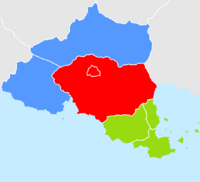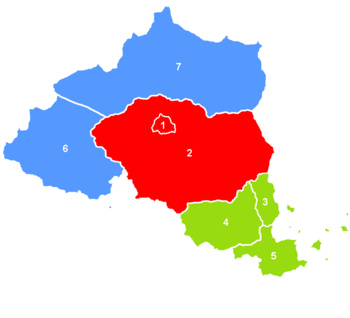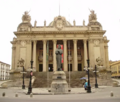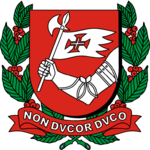Belmonte
This article is incomplete because it is pending further input from participants, or it is a work-in-progress by one author. Please comment on this article's talk page to share your input, comments and questions. Note: To contribute to this article, you may need to seek help from the author(s) of this page. |
United Republic of Belmonte República Unida de Belmonte (Luzelese) | |
|---|---|
Motto: Non ducor, duco (Solarian) "I am not led, I lead" | |
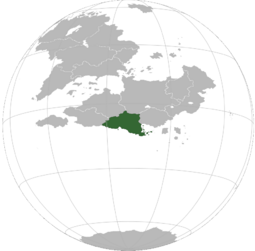 Belmonte (green) in Asteria (grey) | |
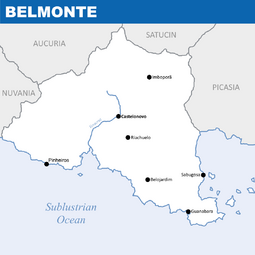 Political map of Belmonte | |
| Capital and largest city | |
| Ethnic groups (2020) | 41.3% White 40.2% Mixed 14.6% Black 2.6% Coian 1.3% Asteridian |
| Religion (2020) | 86.9% Sotirianity -67.4% Solarian Catholicism -19.5% Amendism 11.8% Irreligious 1.3% other |
| Demonym(s) | Belmontese |
| Government | Federal parliamentary republic |
| Caetano Villa-Lobos | |
• Premier | Graça Fonseca |
| Legislature | National Congress |
| Senate | |
| Chamber of Deputies | |
| Independence from | |
• Declared | 07 August 1764 |
| 21 November 1771 | |
| 15 August 1764 | |
• Republic | 18 April 1792 |
| 06 July 1935 | |
| Area | |
• Total | 1,003,144 km2 (387,316 sq mi) |
• Water (%) | 0.5 |
| Population | |
• 2020 census | 36,334,190 |
• Density | 36.2/km2 (93.8/sq mi) |
| GDP (PPP) | 2020 estimate |
• Total | |
• Per capita | |
| GDP (nominal) | 2020 estimate |
• Total | |
• Per capita | |
| Gini (2020) | medium |
| HDI (2020) | high |
| Currency | Cruzado (BEC, ₡) |
| Time zone | UTC+13 (Belmontese Central Time) |
| Calling code | +57 |
| Internet TLD | .be |
Belmonte (/ˈbɪlˈmærˈtɪ/; Luzelese pronunciation: [bewmɔnte]), officially the United Republic of Belmonte (Luzelese: República Unida de Belmonte), is a country located on the continent of Asteria Inferior, sharing borders with Nuvania to the west, Aucuria to the northwest and Satucin to the northeast.
The current Belmontese territory was inhabitated by several indigenous peoples since 10,000 BCE, being discovered by Luzela after an expedition led by explorer Duarte Bórgia in 1503, with colonization beginning years later with the establishment of the first captaincies. In 1683, Belmonte was given to Poveglia on the aftermath of the Luzelese-Poveglian War and would be transferred again after the Congress of Cislania to the Gaullican Empire, whose harsh oppression towards the population led to the declaration of independence and a large-scale uprising in 1764 during the Asterian War of Secession. Independence was recognized years later through the Treaty of Vicalvi in 1771, and an oligarchic confederation was established. As republican and illuminist ideas arose, the confederation would be replaced by a presidential republic in 1792 after a civil war.
Although free at first, the republic would evolve into a one-party radical state, causing dissatisfaction among conservative groups who launched a successful military coup in 1828, putting a conservative authoritarian dictatorship in power. However, this dictatorship would be overthrown by the Armed Forces in 1836 followed by the creation of a oligarchic parliamentary republic, with an agreement between conservatives and liberals leading to long-term stability. This agreement would be broken later, causing a political crisis which led to another military coup and the establishment of a provisional military junta. This junta would, after rigged elections, give power to politician João Berquó, who ruled as a dictator for almost 20 years. Belmonte was invaded and occupied during the Great War through Operation Palmier, with a large-scale offensive liberating the country in 1934. The war made the democratic opposition gain support from the military, which ousted Berquó and allowed the creation of the current democratic regime.
Today, Belmonte is a federal parliamentary republic, with the president acting as head of state whilst the premier acts as the head of government. The legislature is the bicameral National Congress, which is composed by the Chamber of Deputies and the Senate. Its capital and primate city is Castelonovo. Belmonte is a developing country with an emergent economy, having a high Human Development Index of 0.784. Currently, Belmonte is a member-state of the Community of Nations, the Asteria Inferior Common Market, the International Council for Democracy, the International Trade Organization and the Global Institute for Fiscal Affairs.
Etymology
Before the arrival of Euclean peoples in Asteria Inferior, there were several indigenous peoples present in Belmonte's modern territory, the majority of them from Tupi origin, who named the area as Apiraby - pointy land, likely referring to the region which is today the provinces of Favônia and Laranjeiras. Further inland, the region was named Araxaiby - high land.
The word Belmonte is from both Luzelese and Vespasian origin and means "beautiful mountain." The most likely theory is that the name was first used to designate St Paul's Mount, which was the first piece of land seen by Duarte Bórgia's 1503 expedition that discovered the country, being officially adopted as colonization began years later.
During the Gaullican period of rule in the region, its name was Gallicized to Beaumont, however, it saw few use by the majoritarian Luzelese population, changing back to Belmonte once independence was achieved in 1764.
History
Pre-Ashtarite era
The first archaeological evidence about the presence of the homo sapiens in Belmontese soil dates back to 60,000 thousand years ago, but permanent human habitations only exist for at least 10,000 years. The indigenous population was based around tribes which had an extended knowledge over pottery cultures and had a complex political system based around the image of the tribe's leader, the cacique, and its religious and spiritual chief, the pajé, along with societal ranks akin to a nobility system. Before the arrival of Duarte Bórgia's expedition in 1503, it is estimated that the indigenous population living in Belmonte was comprised of two million people, with the majority of them being part of two ethnolinguistic groups: the Tupi-Guaranis and the Macro-Jês. These two ethnolinguistic groups are divided into the Tupis, Guaranis, Jês, Tupinambás and Tupiniquins, which, in turn, are subdivided into smaller groups based on local cultural and societal differences.
Regarding their expertise on the region they lived in, the natives knew extensively about their local fauna and flora and lived through the subsistence of hunting, fishing and gathering, with tribal boundaries being demarcated through war. Slavery was widely practised, although under a different meaning than the used by Euclean powers, and religious rituals involving cannibalism was common. Religion was characterized by being polytheist with each tribe having its variations, while leadership was hereditary and decided among the tribe's warriors.
Colonial era
Since the discovery of the Asterian continent by Assim Asteris in 1488, many Euclean major powers, including Luzela, launched several expeditions to colonize and explore the newly discovered lands. In 1503, after two failed attempts to colonize the Arucian, the Luzelese Crown decided to launch another expedition to the southern tip of the continent, being led by the admiral and explorer Duarte Bórgia. Bórgia's fleet, composed by 17 caravels, departed from Precea in January 1503 and, throughout the travel, lost 3 ships after a severe storm in the Vehemens Ocean, reaching the St Paul's Mount near Pinheiros six months later on June 29th.

The crew stayed in Belmonte and left a few days later, with other expeditions being launched in 1506 and 1509. At first, the crown didn't have any interest of populating the area but, after Hennehouwe and Esmeira started to proclaim land nearby (which is today the countries of Nuvania and Picasia) as theirs, Luzela was forced to establish the first settlements in 1517, although true colonization only began two years later. In 1521, the colony was divided into captaincies and shared among the nobility, which was empowered to act as local governments. The colonization process was slow and costly, leading to further disinterest by the crown who gave more powers to the captaincies and religious orders such as the Jesuits to act autonomously. Slavery was officially introduced in 1532 to the natives, with the first black slaves from Bahia coming years later.
By the end of the 16th century, most of the Luzelese settlements were located entirely in the coast, with native attacks and slave revolts being a constant threat to the settlers. The own population, without the help of its metropole, launched several independent expeditions, called bandeiras, to expand its territory and explore mineral resources and to capture Indians to use them as a slave force. Over the years, the colonial society was shaped and based around the bandeirante and its figure. Although intense conflicts between Eucleans and Indians existed, miscegenation was widespread, contributing to the creation of an early Belmontese identity and people. After several bandeiras, the captaincies' territory grew and extractivist activities towards the local fauna and flora led to the creation of inland cities such as Castelonovo and Riachuelo as well as a surge in new inhabitants.
In 1683, after the Luzelese defeat at the Luzelese-Poveglian War, the country was forced to give some of its colonial holdings, including Belmonte, to Poveglia. The Poveglians kept some of the power to the bandeirantes and to the well-established elite and even allowed the continuation of the Luzelese language and culture in the colony, but it centralized power towards a new central government and launched efforts to make the region a trade outpost in Asteria Inferior, leading to the expansion of market towns and the establishment of a large commercial fleet, expanding the Vehemens slave trade.
The aftermath of the Ten Years' War and the Congress of Cislania made Gaullica, the major Asterian colonial power, annex Belmonte. Unlike the Luzelese and the Poveglians, the Gaullican colonial administration was widely unpopular among the population, fueling nationalist and illuminist movements in the country. The harsh oppression and high taxes were a reason for both the rural aristocracy and the lower classes to ignite a large-scale rebellion in 1764, thus starting the Asterian War of Secession.
Independence and confederation
Soon after the first uprisings in Belmonte and other Gaullican colonies through Asteria broke out, the rebels were organized into a single army composed by regional militias from the captaincies which were led by Sebastião Mascarenhas, Nuno Calixto and Clemente Bignoli, all of them being members of the rural aristocratic elite. The first years of the campaign were harsh for Belmontese revolutionaries due to the lack of ammunition and experience, but the tides of the war changed in 1766 with the Battle of Humaitá, where Belmontese soldiers defeated a major Gaullican army. The war would only end with the Treaty of Vicalvi signed 5 years later in 1771, with independence being guaranteed by Gaullica and other major world powers.
A confederation system of government was adopted and the Confederation of Belmonte was officially established, with Mascarenhas serving as its first captain-regent during the war and resigning soon after it ended. After his retirement, Bignoli succeeded him, expanding the Belmontese Navy and merchant activities, especially slave trade, throughout Bahia and the Asterias whilst giving power to merchants and rural oligarchs. He was succeeded by his aide Francisco Noronha, who was overthrown by liberal rebels in 1792.
The confederation was characterised by its autocratic oligarchic regime ruled by slave traders and the rural elite. This led to disaffection between former revolutionaries and members of the Armed Forces who fought for a democratic republic, causing the creation of the Liberal Party which supported a new constitution and a federal presidential system of government. In 1788, after crackdowns towards the liberal leadership, a series of low-ranking officers mutinied against confederal rule, erupting into the Federalist Revolt. After 3 years of civil war, the confederation was officialy abolished, and the First Belmontese Republic was established.
Republican era
Following a provisional government responsible for enacting a new constitution and stabilize the country, the first elections were held in October of 1792, with revolutionary Jorge Aranha becoming the country's first president. During his tenure, Aranha consolidated liberal rule throughout Belmonte, created the bicameral National Congress, abolished slavery and expanded voting rights to literate males, causing him to be re-elected for a second term in 1796. During this time, the Belmontese society was realigned and passed through a series of reforms to solidify the new presidential system, incommodating the rural aristocratic classes. These elites would organize themselves as the Conservative Party years later, in 1801, after losing again to liberal candidate Zacarias de Moraes a year ago.
Failed military coups supported by conservative sectors of society made liberal leaders repress their activities, making Belmonte a de facto one-party state. Further oppression towards these conservative groups made by radical Presidents Felisberto Morais and André Mendonça plagued the country with economic and political instability until in the 27th of September of 1828 a military coup successfully removed President Plínio Veríssimo and put the conservative politician Joaquim Durão in charge, officially ending the First Republic.
Intended to be a provisional government, Durão closed the National Congress, cancelled future elections and abolished the 1792 Constitution, effectively becoming a dictator. His dictatorship was characterised by a state of perpetual unrest followed by violent responses towards the political opposition, with many former liberal politicians being forced to flee the country to avoid persecution. By 1836, however, his position became unsustainable, and a revolution led by General Augusto Cintra overthrew his government and sent him to political exile, establishing the Third Belmontese Republic.

To avoid the errors that led to the end of the First Republic, conservative and liberal politicians met and created the Riachuelo Agreement, a political pact to ensure that the government would be led by one of the two parties and that their core interests would be protected, creating an oligarchic rotative system where both conservatives (nicknamed Caramurus) and liberals (nicknamed Moemas) would always stay in power, impending the creation and growth of other political groups. A new constitution was drafted the same year, establishing a parliamentary system of government and having Cintra as its first premier.
The stability of the Riachuelo Agreement made it possible for Belmonte to industrialize, with many landowners now investing in the construction of new factories and railroads, causing a massive immigration of Euclean peoples. Between 1867 and 1901, almost two million immigrants from Paretia, Etruria, Gaullica, Caldia and Werania went to work in Belmontese camps and factories, with another half million of Senrians, Miersans and Estmerish and Hennish people coming in the following years.
The rapid transition of Belmonte to an industrialized society caused social strife and dissatisfaction of the working classes towards the oligarchic regime, being met with police brutality in response. It was only in 1906, after a series of riots in the main cities, that premier Graciliano Gusmão broke out the agreement, leading to a political crisis with the dissolution of the Liberal Party into various radical and socialist parties who are unable to form a stable government. Between 1909 and 1913, eight different governments, most of them left-wing, were formed, causing panic among conservative circles. In 1913, the SBIO won both the presidency and premiership for the first time and, with the Great Collapse destroying the remnants of the Belmontese economy, a military junta took power and closed the National Congress, establishing a military dictatorship.
Claimed to be provisory, the emergency junta abolished all political parties and cracked down on socialists, communists and other left-wing radicals. Two years later, when the economic situation was stabilized, power was given through a rigged election to reactionary politician João Berquó, who would rule as a dictator for the next 20 years. Berquó unified far-right and ultranationalist groups under his party and banned any opposition, establishing a cult of personality around himself.
Great War
Although the Berquó regime had various similarities with the functionalist powers, Belmonte declared its neutrality on the ensuing conflict after the Second Sakata Incident, but continued trading with both sides of the war. This, together with Belmonte's constant refusals to join the war as an Entente member, strategic geographical value and allegations of sending arms to the Aucurian National Redoubt Government, led to Operation Palmier, the invasion of Belmonte by Satucin and Nuvania, in February 7th 1932.
The Belmontese Armed Forces, which hadn't saw any combat since the end of the War of the Arucian, combined with the invasion day set at the height of the carnaval festivities, were crucial factors for the fast movement of Entente troops through Belmontese soil. Three weeks after the initial attacks, Castelonovo was declared an open city and the government set a national redoubt at the city of Paquatinga near the Aucurian border, with the entirety of the remaining army being relocated. In occupied Belmonte, an authoritarian collaborationist government led by functionalist politician Inácio Cohen was established by the occupying forces, but both Nuvanian and Satucin troops stayed for the defence of the new regime.
Soon after the occupation begun, a series of resistance movements, especially composed by democratic and communist groups previously against Berquó's dictatorship, were created, leading to the establishment of the Supreme Belmontese Military Council (CMBS in Luzelese) which would be responsible to orchestrate future resistance acts of both the government and resistance units.
The first three years of the front were characterised by low-intensity battles among the resistance and collaborationists followed by medium acts of terrorism and unrest against Nuvanian and Satucin forces. This would change in 1933, when a series of strategic attacks made by the Belmontese People's Front against Nuvanian targets became a crucial factor for the removal of their troops. During the moving of Nuvanian and Satucin troops, the government, in coordination with resistance cells, launched the Spring Offensive, leading to the total capitulation of Entente forces at the start of 1934.
Contemporary era
With the end of the Great War, Berquó's position in power became unsustainable after years of tensions with moderate conservatives and liberals, who demanded a return of the pre-1906 status of the Third Republic, and the Armed Forces, as they refused to maintain a dictator in power after spending years fighting the authoritarian regimes of the Entente.
In fact, Berquó had already lost power as early as 1933, when liberal-minded generals took total control of the CMBS whilst most of the country was under democratic and/or socialist resistance groups after the end of the conflict, but they decided to maintain Berquó in charge until new elections would be realized. However, after a coup from pro-Berquó sections of the military failed, these groups, now under the leadership of Júlio Lobato, decided to overthrow him in January 1935, with General Patrício Cunha leading a provisional government.
The end of the Berquó Era allowed the return of the opposition who fled to avoid persecution, causing a realignment of national politics as the National Republican Union (URN) became the major political party of Belmonte. A broad big tent party, the URN was mainly composed by former conservatives and liberals of the Third Republic together with Sotirian and social democrats, with those groups ending under conservative, liberal or progressive internal factions. A new constitution would be ratified, and the Fifth Belmontese Republic, also known as the New Republic, was established as a parliamentary republic akin to the Third Republic, with the first democratic elections since 1913 ending in a landslide for the URN and its leader Lobato, who become the country's first democratically elected premier, responsible for enacting a series of economic policies that relieved most of the economy.

Lobato would step down in 1940 and was succeeded by Sílvio Behringer, who continued most of his policies but chose to not run for a second term in 1945 due to health reasons, with the progressive wing of the party being able to elect former resistance leader Cédrico Alvim as premier in a tense transition of power after a failed military coup. Alvim's government was characterised by the expansion of welfare services, nationalization programs and developmental policies under the PND, but internal tensions made him unable to continue as party leader in 1950, leaving the URN and founding the left-wing Social Democratic Party (PSD) soon afterwards. With most left-wing members leaving the party, the URN would establish itself as a conservative right-wing party in Congress, being able to maintain itself in power for the next years under a heavy anti-communist agenda.
In 1963, a series of terrorist attacks performed by the far-left group Belmontese Free Army led to the nomination of hardliner general Lourenço Bittencourt to the premiership, with the country entering an authoritarian phase which resulted in more crackdowns against the opposition - causing the Mauás' War - and the decrease of political and civil rights. It was only in 1969, with the murder of journalist Anderson Figlioli, that a series of protests caused the end of the 39-year URN dominance in national politics with premier Bittencourt's resignation.
The 70s were engulfed in social and political turmoil and a strong recession, with the political situation being stabilized in 1979 with the election of Félix Bragança as premier, who in turn established a series of nationalist left-wing policies, stepping down in 1990. It was only in 1993 that the URN came back to power under Jorge Castelo, returning to opposition years later in 1997 but coming back in the 2000 general election, staying in power for the next 15 years under three different premierships. In 2015, Rita Maurino became the country's first female premier, being succeeded by her foreign secretary Graça Fonseca in 2020.
Geography
Climate
Environment
Politics
Government
According to the Constitution, Belmonte is a federal parliamentary republic, with the president being the head of state whilst the premier is the head of government. The executive is formed by the president, the premier and the cabinet, the Council of Ministers. The president is the highest-ranking officer in Belmonte and the commander-in-chief of the Armed Forces, being elected through the popular vote for a five-year term that could be expanded once. Although it holds most ceremonial functions, it's the responsibility of the president to convoke new general elections, appoint and dismiss the premier and its cabinet, enact new laws, appoint ambassadors, represent Belmonte on the world stage, issue pardons and others. It's expected that the president must act non-partisan when dealing with government issues and has as its advisory boards the State Council and the National Defence Council.
The premier is responsible for lead the Federal Government and the cabinet and is appointed by the president after general elections, being the leader of the party with the majority of seats in Congress. The premier needs parliamentary support to govern and must resign or declare new elections once this confidence is lost.
The legislative power is vested over the National Congress, which is the national legislature of Belmonte. As a bicameral parliament, the Congress is divided into the Chamber of Deputies and the Senate. The Chamber of Deputies is the lower house of Congress, being composed by 206 deputies elected for a renewable term of 5 years through a closed party-list proportional representation system. The Senate is the upper house, being composed by 35 senators elected through a single transferable vote system, with the role of representing all provinces.
Belmonte has a multi-party system, with various political parties exerting significant influence over the national political scene. The three biggest parties are the centre-left Social Democratic Party (PSD), the centre-right National Republican Union (URN) and the left-wing Socialist Bloc (BS), with other major parties being the Sotirian Democrats, Citizens' Alliance, People's Centre Union, Belmontese Section of the Workers' International, Green Party and the National Movement.
Administrative divisions
As a federation, Belmonte is divided between seven provinces. These provinces are within major subdivisions called regions, subdivisions that, despite don't having any political power, were created to assist in the interpretation of statistics and help the Federal Government in enforcing regional policies. All provinces have its constitutions and governments, with the executive being lead by the province’s governor, the legislative by the legislative assemblies and the judiciary by regional courts. The second and lowest level of administrative divisions are the municipalities, which are led by a mayor and has as its legislature the municipal chambers.
The first administrative divisions were adopted during colonial times by Luzela, which divided Belmonte intro three captaincies: Anchieta, Laranjeiras and Juazeiro. These captaincies would be donated to private landowners, all of them from the Euclean aristocracy, to develop the region. Soon after time, these captaincies would become in charge of more responsibilities such as defence and trade, resulting in their expansion as the colony grew. This system was briefly extinguished during the Gaullican rule of the region, but it was re-established with the declaration of independence and the creation of the Confederation of Belmonte. After the Federalist Revolt and the establishment of the First Republic, the captaincies were officially dissolved, with provinces being created but having their borders based on the previous boundaries.
|
|
Judiciary and law enforcement

Belmonte has a codified legal system based on the civil law, an Luzelese judicial heritage, and has as its fundamental law the Constitution, which has been amended 17 times since its promulgation in 1935. Provinces and municipalities also have their constitutions, but they couldn't contradict federal law. The highest national court is the Supreme Court, which acts as a court of last resort and as a constitutional court. The legislation also allows the creation of regional courts to federal subdivisions, being subject to provincial law.
The Civil Guard is the law enforcement agency of the country, being under the responsibility of provincial governments with federal assistance through the National Public Security System. With 100,000 officers, the Civil Guard is one of the biggest law enforcement agencies of the Asterias and acts as a preventive, detective and forensic police force. Other law enforcement agencies are the National Force, which is under federal responsibility and is used in cases of national unrest to restore public order, and the Federal Police, which is responsible for combating crimes against federal institutions, drug trafficking, terrorism, organized crime and others.
The National Information Service is the national intelligence agency of Belmonte, being in charge of espionage and counter-espionage activities.
When compared to international levels, Belmonte has above-average levels of violence, with CON and ICD reports showing a homicide rate of 12 deaths per 100,000 inhabitants in 2019. Homicide levels have been decreasing since the turn of the century except for a violence outbreak in 2003, year which remains as the most violent one in history. Currently, the Belmontese prison system is under a major crisis due to its overcrowding, having a shortfall of almost 100,000 accommodations.
Foreign policy
Belmontese foreign policy is based on the principles of non-interventionism and international cooperation with nations and foreign institutions, principles which have been used since the establishment of the New Republic. Since the end of the Great War, Belmonte has as its most important allies Marchenia, the North Vehemens Organization and the Euclean Community, and has been a major sponsor of bigger integration among Asterian countries. Due to its opposition against South-South cooperation and support for Northern Powers, many specialists see Belmonte as a middle power due to its efforts of impending a Satucin-based hegemony in Asteria Inferior.
Currently, Belmonte is a member-state of the Community of Nations, the Asteria Inferior Common Market, the International Council for Democracy, the International Trade Organization and the Global Institute for Fiscal Affairs.
Military
The Belmontese Armed Forces are divided into three branches: the Army, the Navy and the Air Force. Together, they have a personnel of 175,000 people, both active and reserve soldiers, one of the smallest of Asteria Inferior. Conscription was officially disbanded in 1973 and is in no longer use since then. Since the last time Belmonte was invaded was during the Great War in 1932, the Armed Forces shifted most of its operations to anti-terrorist activities and humanitarian missions worldwide, being present in various CON-mandated peacekeeping missions.
The Army is the biggest and most powerful of the three branches, having a total of 75,000 soldiers by 2019. The Navy is the second biggest branch of the Armed Forces, being considered to be a green-water navy capable of performing military activities beyond the national exclusive economic zone. Most of its components are made of corvettes and is one of the few navies in the Asterias who has an aircraft carrier - the MB Bórgia. The Air Force has about 200 manned aircraft in service, being currently under a modernization program.
Economy
Energy
Infrastructure
Tourism
Demographics
Population
Race and ethnicity
Immigration
Religion
Health
Education
Science
Urbanization
Culture
Architecture

Belmontese architecture was largely inspired by Euclean trends during its history, only starting to develop its own variations after the Great War. During colonial times, Belmontese buildings were based on the baroque and rococo architectures through the concept of few external designs and heavily decorated interiors. Both forms were mainly used by the Church and Jesuit missions located there, becoming widely used by the civilian population at the time soon after.
The two genres remained popular until the second half of the 19th century, when it started to be replaced by neoclassicist and eclectic styles. During the late 1910s and early 1920s, eclecticism started to be slowly replaced by the Gaullican Art Noveau and Art Decó, but they were never truly accepted as mainstream due to the outbreak of the Great War and Belmonte's invasion by the Entente.
After the war, many artists came back to Belmonte, starting the modernist movement in the country. Modernist architects such as Cláudio Bachlechner, Luís-Eustáquio Diniz and Margarete Saval became the most known architects of the time, being responsible for projecting numerous works between the late-1930s until the early-1970s. The URN government, although conservative, funded modernist art to present Belmonte as a contemporary country, causing a total rejection and prejudice of previous trends during this period.
Modernist architecture remained the Belmontese mainstream until the late-1990s when it started to be replaced by post-modernist and international style trends. Due to its presence in the majority of the late-20th century, the style remains extremely influential, leaving a huge mark that defined most of the national cultural identity.
Music
Belmontese music is known for its diverse origin and influences that came from several parts of the globe. Classical music was brought by the Luzelese nobility and Jesuits, being initially from baroque and sacred origin. After the Federalist Revolt, new orchestras and conservatories were established, with many composers started transitioning to Romanticism by the 1850s and 1860s. Romanticism started to be slowly replaced by more nationalist trends over the turn of the century, with the era being marked by the works of Maurício Sobral and Lauro Cruz. After the Great War, classical music started to be influenced by more contemporary trends.
The first Belmonte popular manifestations were the modinhas and lundus. Over the time, both genres evolved into serestas and, when the country started to industrialize at the beginning of the 1850s, foreign Euclean music and dance such as waltz, polka, xote and tango became widespread, with the junction of them originating the choro in the late 1880s and early 1890s.
By the turn of the 20th century, samba was created, becoming famous among black communities in Ípsia. Despite being relatively popular in the 20s, the genre found its height in popularity during the 30s and 40s. As the 50s progressed, a new subgenre of samba was created by Gilberto Lins - the bossa nova - which sought to add jazz elements to the music, creating a more urban sound. The genre, alongside the Maracan estranova, found itself under international recognition in the 60s under the voice of Ricardo Alvim and his song The Girl from Atalaia. Together with other artists such as Lira Duarte and Olavo Farias, the rhythm reached worldwide popularity. In the 70s, the tropinova movement was created, having as its most famous singers Maurício Buarque, Jorge Mourinho, Eleonor Cruz and Gil Nkosi.
The late 70s and early 80s saw the popularization of rock music under post-punk and new wave influences, with bands such as Saturno, Excelsior, Longe das Capitais, Enfant, Arquitetos de Imágua and L'eau became widely known. By the turn of the century up to present times, the Belmontese musical scene remains extremely diverse, with the 2010s seeing a surge of indie rock, electronic music and pop.

Literature
Belmontese literature started with the consolidation of Jesuit missions in the colony, with the local literature, at the time influenced by religious dogmas, started to shift into more baroque trends. However, it was only after the establishment of the First Republic that new schools of thought and artists appeared into the national scene. Baroque started to be replaced by romanticism by the 19th century, and, over time, indianism was created, having a strong progressive tone that promoted indigenous values and culture, having Aldo Paes's romances Tupi and Iandara as the subgenre's biggest works.
By the late-1870s and early-1880s, romanticism started to be substituted by realism, with the genre itself becoming widely known thanks to Gregório Assis and his books Obituary and Bento, leading him into universal acclaim as Belmonte's greatest writer. Realism continued to be the main Belmontese literary doctrine up to the 1930s with the beginning of the modernist movement in the country. By the 70s, the modernist school would be replaced by post-contemporary and regionalist trends thanks to the works of Cecília Wiśniewski.
Cuisine
Belmontese cuisine is influenced by the Euclean, Bahian and indigenous cookery, being the result of the contact between these peoples. Before the beginning of colonization, the native population used the local fauna and flora as the base of their cuisine, largely consuming cassava, guarana and açai. With the arrival of Luzelese colonizers in the 16th century, Euclean foods were added into the Belmontese cuisine, being adapted to the local climate. The introduction of slavery at the same time also led to Bahian peoples bring their food to the forming Belmontese culinary at the time, which evolved as more peoples from different cultures went to live there.
As the result, Belmontese cuisine is extremely diverse. Fish is the most eaten meat in the country, being present in moquecas and vatapás. Other consumed Belmontese foods are pão de queijo, mbeju, akara and beans - being consumed either as tropeiro beans, brown beans or feijoada. Belmonte also has a variety of sweets, with the most popular ones being the escurinho and bolo de rolo. The country's national drink is coffee whilst its national liquor is the cachaça, although wine is more consumed.
Cinema and theatre
Belmontese theatre had its origins in the colonial era, being brought from Euclean churches and monasteries by Jesuit priests to the newly-established colony. First confined within the Church, the first productions were influenced by religious and medieval traditions, with many of them being used as a form of conversion towards indigenous peoples. Catholic influence on theatre remained widespread until the 20th century, when many theatrical schools started to being funded by the state. Today, the scenario largely relies on the government to maintain itself, but is extremely diverse and well-acclaimed by critics from all kinds.
The beginning of Belmontese cinema started in 1899, when the first projectors came from Gaullica, with the first cinema room being inaugurated in Castelonovo in the same year. The country's first movie, "Panorama of Ípsia from the Lausanne", was only released a year later, being 3 minutes long. Although its introduction was greatly covered by the excited press at the time, its development was extremely slow, being only accessible to the urban elite due to its highly expensive tickets and difficulty of maintaining cinema rooms throughout the country.
However, this was promptly changed after the National Renovation Coup and Berquó's ascession to power. The dictatorship, suffering massive opposition, attempted to increase its popularity by controlling and funding the means of communication, including cinema, leading to the production of several propaganda films known for their nationalistic and overly patriotic nature.
The establishment of the New Republic in 1935 led to a golden era of cinema as the country produced highly popular movies. It was during this time that actors such as Tina Bianchi, Arlete Sampaio and Lauro Lima reached their height in fame, being present on several movies of the time. During the 70s and 80s, Belmontese cinema started to transition into a more underground period, being marked by the pornochanchada genre, meanwhile, the 90s were known by its cult-esteemed films. By this day, Belmonte is one of the biggest movie producers of Asteria Inferior, leaving a large cultural footprint on the continent.
Media
Written press was introduced to Belmonte in 1764 with the foundation of the Gazeta de Castelonovo, which served as the country's government gazette. After the Federalist Revolt, Belmontese press became freer, with several liberal-minded newspapers being created at the time. Although this was temporarily halted during the Durão Era, the proliferation of newspapers and magazines continued during the remaining of the 19th century up until the National Renovation Coup in 1913. Despite the 1935 Constitution declared freedom of speech a fundamental right, it remained tightly controlled by the consecutive URN governments of the time up until the 70s, when censorship was officially abolished.
Currently, the highest-circulating Belmontese newspapers are the centre-right Diário (also considered to be the national newspaper of record), the centre-left Republicano and the right-wing A Nação. Ever since the turn of the century, newspaper sales have decreased considerably, with many switching their focus to the rising digital scene in recent years.
Radio broadcast started in Belmonte in 1921. In 1922, the state-owned Agency Belmonte was created, being the only allowed broadcasting company at the time. In 1949, premier Alvim expanded and reformed the agency into the Public Broadcasting Company (EPC), also being the first Belmontese television network with the introduction of television in the following year. Today, the EPC remains as the biggest and most viewed broadcasting company of Belmonte, being followed by the Excelsior Network and Tupi Television, both of them from private origin.
Art


Belmontese art emerged in the 16th century, when the country still was a colony, being entirely influenced by the baroque and rococo religious themes of the time. At the beginning of the 19th century, both genres started to be replaced by the more humanist and nationalistic tones of neoclassicism and romanticism, having as its most famous painters Ulisses Braga and Henrique Bercout. Initially largely inspired by Euclean schools and doctrines, both genres started to develop regional characteristics thus leading to indianism, which was known for its progressive rhetoric that exalted not only indigenous peoples but also the Belmontese fauna and flora.
With the formation of a single Belmontese cultural identity by the 1860s and 70s, the majority of artists of time founded the National Academy of Arts of Belmonte in 1878, being the only artistic entity in the country at the time. During the 1890s, both previous genres became substituted by realism and impressionism, which quickly found itself promoted within the academy under the paintings of Enzo Cinetti and Elisa Sampaio, becoming part of the artistic mainstream of the time.
As the country's industrialization progressed by the beginning of the 20th century, the first modernist trends started to be introduced in Belmonte. First rejected by the academy, expressionism, fauvism, cubism and futurism quickly became extremely popular among the Belmontese urban class but it was rejected and persecuted by the Berquó regime which sought for more nationalist and traditionalist themes.
After the creation of the New Republic, many modernist artists who went into self-imposed exile returned to Belmonte, with painters Teresa Behamonte, Irineu Ricci and Rita Cavalcante organizing the Castelonovo Modern Art Week of 1937 thus founding the modernist movement in the country. Unlike its predecessor, the URN government not only allowed but promoted modern art, which reached its height in the 50s and 60s. By the 80s, modernism started to be slowly replaced by postmodern and regional trends, but still remains an influential part of Belmontese history and culture.
Sports
Football is the most famous and practised sport in Belmonte, being an integral part of the country's culture. The Belmonte Cup and Primeira Divisão are the major national football leagues in the country, both of them organized by the Belmontese Football Confederation (CBF), with the Primeira Divisão being the primary and most competitive competition whilst the Belmonte Cup is its domestic counterpart. Followed by football, volleyball and basketball also are very popular, having its competitive professional leagues and a large amount of media coverage and practitioners.
Water sports also have a large presence in Belmonte, especially swimming and sailing. Furthermore, the country has as its national sports footvolley (the combination of football and volleyball), futsal (indoor football) and beach football. Besides, auto racing, athletism, tennis, boxing, handball, rugby and hockey are also very practised.

National holidays
| Date | Local name | Name | Observation |
|---|---|---|---|
| 1 January | Confraternização Universal | New Year's Day | Beginning of the year |
| 17 February | Dia da Liberação | Liberation Day | Liberation of Belmonte from Entente powers |
| 1 May | Dia do Trabalhador | Labour Day | Tribute to workers |
| 18 April | Proclamação da República | Proclamation of the Republic | Proclamation of the First Belmontese Republic |
| 13 June | Santa Catarina | Saint Catherine | Belmonte's patroness day |
| 7 August | Independência | Independence Day | Independence against Gaullica |
| 2 November | Finados | All Souls's Day | Day of remembrance of the dead |
| 25 December | Natal | Nativity | Major Sotirian celebration |


















